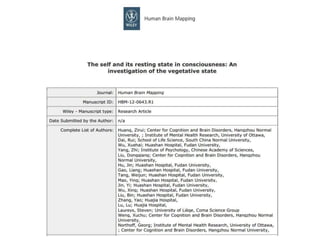Vs self rest
This document discusses disorders of consciousness (DOC), including the vegetative state (VS) and minimally conscious state (MCS). It presents findings that some VS patients showed brain activity in response to their own name, suggesting some level of self-awareness. The study aimed to investigate neural responses to self-referential stimuli and resting state activity in midline brain regions of DOC patients compared to healthy controls. Results found reduced responses in DOC patients during self-referential tasks in anterior and posterior midline regions. The magnitude of response correlated with patients' level of consciousness. Resting state abnormalities were also observed, including reduced amplitude and connectivity in midline regions.


















Recommended
















































More Related Content
Viewers also liked (17)
































Similar to Vs self rest (20)








































Vs self rest
- 2. ? Consciousness is often conceptualized as en- compassing two cardinal elements (Laureys 2005): ©C wakefulness: refer to the level of consciousness ©C Awareness: refer to its contents
- 4. Introduction ? disorders of consciousness (DOC)(Monti. 2012) ©C Coma: lack both awareness and wakefulness ©C Vegetative State(VS): basic vegetative nervous functions are preserved, but in the absence of any sensation and thought ©C Minimally Conscious State(MCS): not only to be wakeful (like vegetative-state patients) but also exhibit inconsistent but reproducible signs of awareness of themselves or their surroundings ©C locked-in syndrome(LIS): both awake and aware but are either unable to produce any motor response
- 5. Introduction ? self-referential processing in DOC: ©C Di et al. (2007): five out of seven VS patients exhibited primary auditory activity in response to their own name. In addition, in two VS patients (and all MCS patients),activations in higher-level posterior temporal cortices were also detected. ©C Qin et al. (2010) reported significant activations for six out of seven VS patients in one or more of three medial prefrontal regions previously linked to processing self-related stimuli ? Resting state in DOC: ©C alterations in cortical midline structures, abnormally low functional connectivity (Boly et al., 2009; Cauda et al., 2009; Vanhaudenhuyse et al., 2010) and effective connectivity (Rosanova et al., 2012).
- 6. Questions ? 1) In DOC, the temporal dynamics of resting state activity, such as the amplitude of low-frequency fluctuations (ALFF)(Kannurpatti and Biswal, 2008; Zang et al., 2007) and standard deviation of neural activity changes across time (Garrett et al., 2011), remain to be thoroughly investigated. Importantly, the functional implications of abnormalities in the resting state remain unclear ? 2) It is unclear how to relate self-referential processing, resting state activity and consciousness in DOC patients.
- 7. Hypothesis and Aim ? (1) the neural response to self-referential stimuli in the midline regions would be present though abnormally reduced in DOC patients; a particularly strong link between neural responses in midline brain regions and the level of consciousness, ? (2) abnormal brain responses while processing self- referential tasks may be related to impairments not only in the spatial domain but also with temporal abnormalities in neuronal measures of resting state activity, e.g. lower ALFF and standard deviation within the midline regions
- 8. Materials and Methods ? Participants and patients ©C 12 healthy control subjects ©C 11 patients (six VS and five MCS)
- 9. fMRI scan procedure Resting 6min task 8Ī»8Ī»Ī» task 8Ī»8Ī»Ī» task 8Ī»8Ī»Ī» task 8Ī»8Ī»Ī» T1 Trial Trial 8s,10s,12s 20 self-referential & 20 non-self-referential, delivered in a pseudo-random order.
- 10. Results ? Behavioral data: from longitudinal behavioral assessments (CRS-R) ©C VS5 and VS6 exhibited clinical improvement and were classified as MCS two months after the fMRI study ©C Patients MCS3 and MCS4 recovered 2 months after the fMRI, and were able to repeatedly follow a command to move and verbally answer to their names.
- 12. fMRI Results
- 14. ? healthy group > DOC patient group
- 18. Conclusion ? DOC patients exhibit reduced cortical responses compared with healthy controls during active self-referential processing in anterior and posterior midline regions. ? The magnitude of cortical responses in the anterior midline regions (e.g. PACC) was significantly correlated with DOC patientsĪ» degree of consciousness. ? PACC displayed major resting-state abnormalities as manifested by reduced ALFF, FC, and SD of signal changes.






